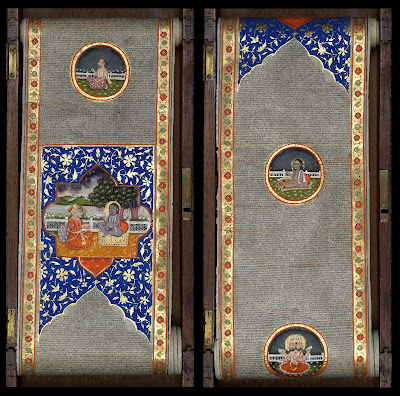

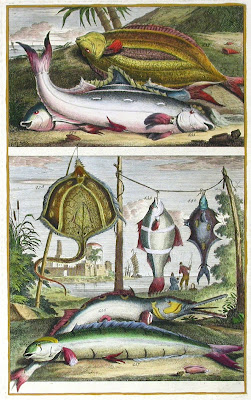









Piscatorial couturier Franciscus Valentijn debuted his garish new season collection at the 1726 Nieuw Oost Indien show.
"Colour is the new scale for the smart fish set", said the beaming Valentijn. "Demure is dead. Stripes, high contrast and bold tints are where it's at."
Citing Louis Renard as an influence, Valentijn said his background as evangelist and cartographer for the Dutch East India Company gave him an opportunity to view the East Asian fashion scene first hand.
"These fish from Indonesia and Ceylon are not shy. They aren't restricted by the narrow palette of their conservative European cousins. They are colour experimentalists. I'm just trying to bring this sense of joy and vivacity to life. My collection is for the party fish inside all of us."
Indeed. We're hooked!
Saturday, April 07, 2007
Party Fish
Friday, April 06, 2007
The Book of Curiosities
(The Book of Curiosities of the Sciences and Marvels for the Eyes)

{Looks like this link won't work because of a session timer - seems you have to
click on the link below each map at the site (9 pages of thumbnails)}


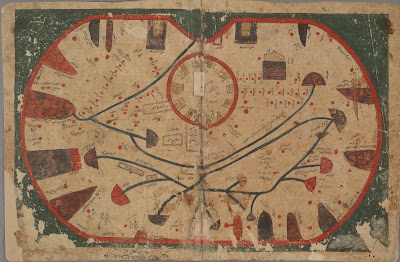


{from the chapter, 'On the blowing of winds, earthquakes and tremors'}




(this picture has been turned 90 degrees)
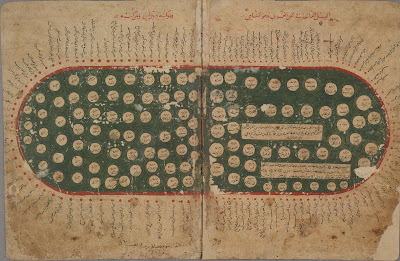


The Bodleian Library at the University of Oxford has launched a fascinating and detailed website presentation of 'The Book of Curiosities'.
Composed in Egypt in the first half of the 11th century, this recently discovered 12th/13th century cosmographical manuscript contains highly unique celestial and terrestrial maps, including the first known rectangular map of the world produced before the renaissance [I believe this has the first known map reference to England: 'Angle Terre']. The geographical references are based largely on the first century work of Ptolemy but the manuscript contains previously unknown distinct cartographic features.
In conjunction with the maps, the text provides insight into the customs and beliefs of the people and details about the commerce and trade routes in the Islamic Empire just prior to the start of the Crusades.
'The Book of Curiosities' is actually divided between 2 books (the universe and earth), and at the time of its purchase by the Bodleian in 2002 it was described as the most important Islamic scientific manuscript to have come onto the market in the last century. The whole of book 2 (earth) and parts of book 1 are presented in high resolution format with mouseover translations, arabic and english pop-up transcriptions as well as footnotes and map legends. I spent more than an hour just browsing around before downloading some sample images.
All of the maps (except the one I rotated) have north at the bottom. Why?
See also: cartography / Arabic.
Tuesday, April 03, 2007
The Bhagavata Purana



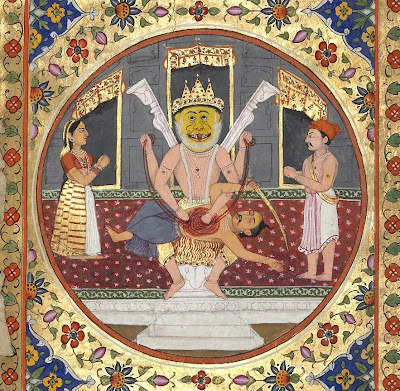




The vast and exceedingly complex body of work that constitute the Hindu scriptures consists, in the most simplistic terms, of the ancient Vedas (rituals, mantras, hymns); the Upanishads (spiritual interpretation of the Vedas); the post-Vedic literature (including such epics as the Ramayana and the Mahabharata); the Bhagavad Gita or Divine Song (a kind of practical guide to life); and the Puranas (mythological tales about the origins of the world, culture and deities).
The Bhagavata Purana concerns itself with the exploits of the Hindu god Vishnu in his various incarnations (avatars), and particularly as Krishna. It records a dialogue between a King who has 7 days left to live and a Saint who agrees to teach the King about the meaning of life. The purpose of the Bhagavata Purana is to enable a person to overcome the fear of death by the process of bhakti yoga - the spiritual practice of cultivating a loving devotion to the Supreme God-of-Gods.
The images above come from a 45 feet long, 17th century silk-paper illuminated scroll, which is obviously mounted in a wooden box. This sacred Bhagavata Purana scroll is hosted by the Rylands Library at the University of Manchester - it employs a LunaInsight browser arrangement [search on 'hinduism']. I've posted about 2/3 of the available images and the details above are all spliced screencaps - click on the images for larger versions.
- Hindu scripture/Bhagavata Purana at wikipedia.
- 'Stories of Krishna: The Adventures of a Hindu God' - an excellent presentation from Seattle Museum based on artworks of Krishna (audio/flash).
- Śrīmad Bhāgavatam (Bhagavata Purana) - the text.
- I preferred the childrens' version: 'Tales From The Bhagavatham Retold For Children by PS Krishna Iyer.
- 'Manas: India and its Neighbours' at UCLA.
- 'The Invention of the Hindu' from Axess Magazine (cache) via a great Metafilter post.
Monday, April 02, 2007
The Stuff of Life
"The old world is dying away,and the new world struggles to come forth:now is the time of monsters."[attributed to Antonio Gramsci] {source}








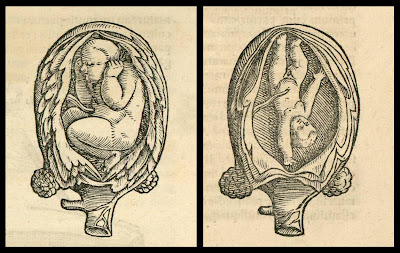





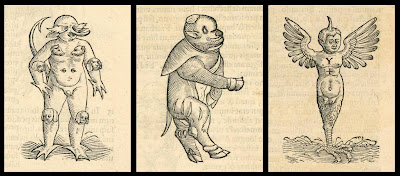







[click images for much enlarged versions : some of the baby-in-womb images have had the surrounding snips of text removed]
I had half-drafted a sarcastoamusing spiel involving placenta boom boxes, liver umbrellas and the vagaries of horizontal folk dancing but then I discovered the illustrations from one of the 3 books above are actually available elsewhere and I lost the urge to continue. So this becomes the half-hearted post instead.
'De Conceptu et Generatione Hominis' by Jacob Rueff (1554) has just been posted to the University of Strasbourg [link updated Feb. 2013]. I think it's the only complete copy online. 2 of the images above (2nd pregnant woman anatomy and midwife delivering baby) are from a 1580 edition (source). This is the (?)first textbook on midwifery. [see also: Lilly Library medical book exhibition/bibliography at Indiana University]
I want to know what is the device hanging off the belt at the back of the midwife? Does she play the bagpipes I wonder?
The first image in this post comes from another edition - among the Bibliothèque Interuniversitaire de Médecine {BIUM} exhibition site on Rueff (Rüff) [from 'Les Monstres'] .
Incidentally, the triumvirate of monsters seen above are symbolic illustrations of abnormalities that occurred in actual births in the 16th century. I believe these are the originals woodcuts - I've posted copied versions from later books before. 'De Conceptu..' has a number of illustrations of the more realistic birth defects too, if that is your thing.
The foetal skeleton illustrations come from unquestionably the most bizarre anatomy book of the renaissance/early modern era. 'Thesaurus Anatomicus' by Frederik Ruysch (1601) is available in its entirety also from BIUM (I, II). The book precipitously straddles both taste and genre as it presents the anatomical collection of Ruysch as a form of wunderkammer or cabinet of curiosity. There was a twisted mind behind some of the illustration arrangements. This is carnival medicine.
Finally, the last 3 dual images above are from Jacopo Berengario da Carpi's 'Isagogae Breves Perlucidae ac Uberrimae in Anatomiam Humani Corporis...' from 1523. I nabbed these images from BIUM which posted the whole book online in recent times. But all the illustrations - better quality too - are available at Historical Anatomies on the Web. So it goes..






